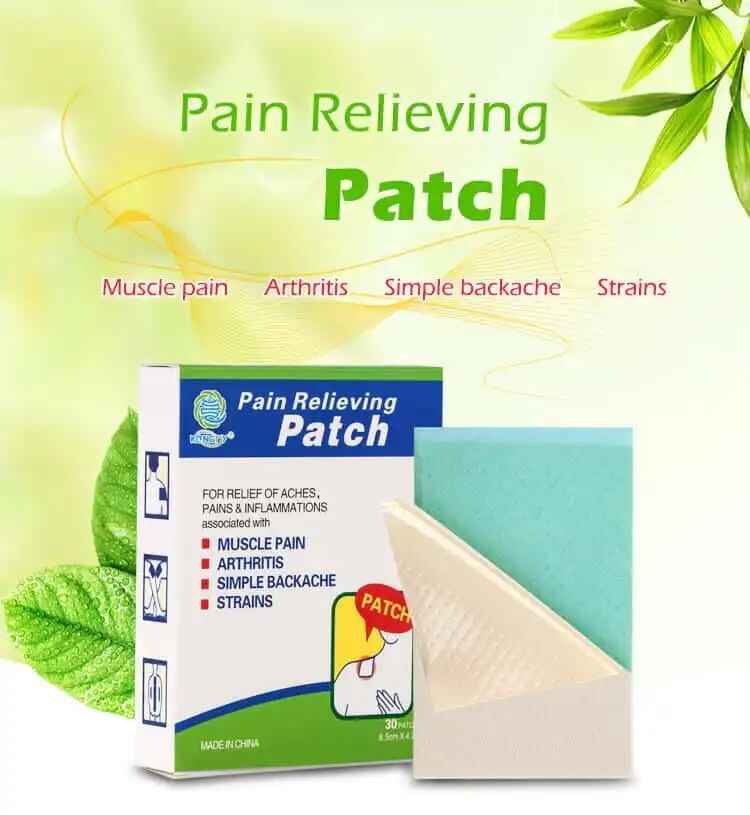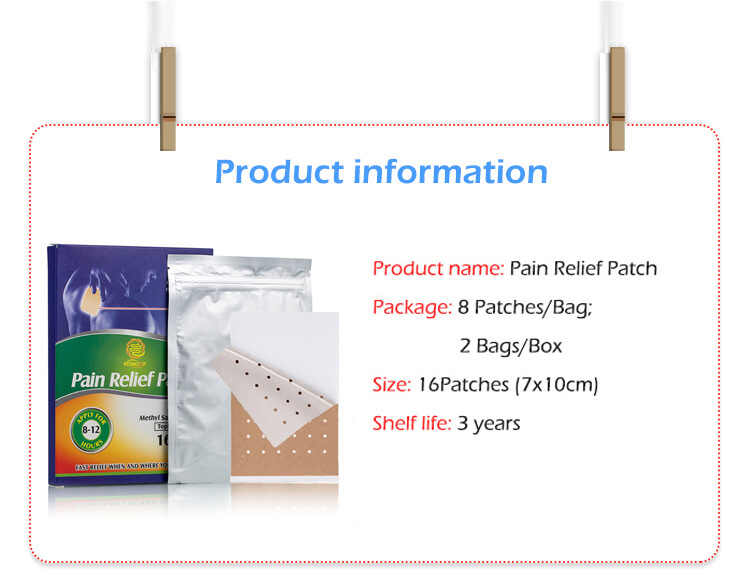Can a Chronic Pain Patches Supplier Help Me Create Herbal Patches?
As the demand for natural wellness products continues to surge, businesses are increasingly exploring the potential of herbal-based solutions—especially in the pain management sector. One common question from entrepreneurs and brand owners is: Can a Chronic Pain Patches Supplier help me create herbal patches? The answer is a resounding yes, especially if you're working with a supplier that doubles as a Chronic Pain Patches OEM.
In this comprehensive guide, we’ll explore how a qualified Chronic Pain Patches Supplier can assist you in developing effective, safe, and market-ready herbal patches, tailored to your brand’s goals. We’ll also delve into the differences between standard manufacturers and OEMs, and how your choice can directly influence your product’s success.

1. Understanding Herbal Chronic Pain Patches
Herbal chronic pain patches are transdermal patches infused with plant-based ingredients known for their analgesic, anti-inflammatory, or muscle-relaxing properties. Common ingredients include menthol, camphor, arnica, ginger, turmeric, and capsaicin.
These patches provide a natural alternative to pharmaceutical pain relief, appealing to health-conscious consumers who want effective solutions without synthetic chemicals.
2. What Role Does a Chronic Pain Patches Supplier Play?
A reliable Chronic Pain Patches Supplier is much more than a product distributor. The best suppliers—especially those operating as a Chronic Pain Patches OEM—offer end-to-end support, including:
Ingredient sourcing
Formulation customization
Regulatory guidance
Packaging and branding
Product testing and quality assurance
They can help you develop Custom Chronic Pain Patches tailored to specific target markets, such as athletes, seniors, or those with arthritis.
3. How a Chronic Pain Patches OEM Helps You Create Herbal Patches
When your Chronic Pain Patches Supplier also functions as an OEM, they offer unique advantages that enable you to develop Private Label Chronic Pain Patches using herbal ingredients. Here’s how:
a. Customized Herbal Formulations
OEMs work with experienced chemists and herbalists to craft custom formulas based on your requirements. Want a warming patch with ginger and capsaicin? Or a soothing blend with lavender and arnica? An OEM can make it happen.
Benefits:
Personalize based on consumer preferences
Differentiate from generic products
Address specific pain types (e.g., joint pain, menstrual cramps)
b. Ingredient Sourcing and Quality Control
A professional Chronic Pain Patches Manufacturer ensures all herbal ingredients are:
Ethically sourced
Tested for purity and potency
Compliant with regulatory standards (FDA, ISO, etc.)
This level of oversight is critical to maintaining efficacy and safety in your Custom Chronic Pain Patches.
c. Advanced Transdermal Technology
Not all herbs are easily absorbed through the skin. A Chronic Pain Patches OEM uses technology like:
Microneedle patches
Hydrogel bases
Time-release systems
These techniques enhance bioavailability, ensuring active herbal compounds penetrate the skin and reach targeted tissues effectively.
d. Packaging, Labeling & Private Labeling Support
OEM suppliers offer comprehensive Private Label Chronic Pain Patches services:
Customized packaging to reflect your brand
Label compliance for local markets
Flexible packaging options (single-use, resealable, eco-friendly)
This allows businesses to enter the market quickly with a fully branded product line.
4. Benefits of Creating Herbal Patches with a Chronic Pain Patches Supplier
Choosing to work with a full-service Chronic Pain Patches Supplier—especially one that offers OEM capabilities—comes with numerous advantages:
i. Faster Time-to-Market
OEM suppliers already have the infrastructure, knowledge, and supply chains in place. This accelerates product development and launch.
ii. Lower Development Costs
You don’t need to invest in your own formulation lab or production facility. The OEM model reduces overhead while maintaining product quality.
iii. Full Customization
From formula to fragrance, from shape to size, you can create a product that truly represents your brand.
iv. Competitive Differentiation
With the rise of generic patches, herbal formulations give you a unique selling proposition (USP) in an oversaturated market.
v. Regulatory Compliance
OEMs guide you through the legal landscape, including claims, labeling requirements, and safety standards.
5. Examples of Herbal Ingredients Commonly Used in Chronic Pain Patches
| Ingredient | Benefits | Common Use |
|---|---|---|
| Menthol | Cooling, analgesic | General muscle soreness |
| Camphor | Anti-inflammatory, numbing | Arthritis, sprains |
| Arnica | Reduces bruising & swelling | Sports injuries |
| Turmeric | Natural anti-inflammatory | Joint and back pain |
| Ginger | Increases circulation | Menstrual pain |
| Capsaicin | Heat therapy, desensitizes nerves | Neuropathic pain |
A Chronic Pain Patches OEM can guide you in choosing the right combination of these ingredients based on your target audience.
6. Key Factors to Consider When Choosing a Chronic Pain Patches Supplier for Herbal Formulations
✅ Proven OEM Experience
Look for a supplier with extensive experience in herbal patch development.
✅ Transparent Ingredient Sourcing
Check if they disclose sourcing origins and testing certifications.
✅ Customization Flexibility
Ensure they can adjust dosage, shape, release rate, and patch base material.
✅ Regulatory Knowledge
A supplier familiar with FDA, CE, and ISO standards can help avoid compliance issues.
✅ MOQ (Minimum Order Quantity)
OEMs often provide flexible MOQs to support startups and small businesses.
7. Why Herbal Chronic Pain Patches Are the Future
The global shift toward natural remedies and plant-based wellness is not a trend—it’s a movement. Consumers want:
Fewer side effects
Eco-conscious production
Ingredients they can pronounce
This positions Custom Chronic Pain Patches using herbal formulations as a high-demand, low-competition product segment—if done right.
Working with a knowledgeable Chronic Pain Patches Manufacturer or OEM Supplier allows you to bring these herbal innovations to market confidently.
Conclusion
So, can a Chronic Pain Patches Supplier help you create herbal patches? Absolutely—especially if the supplier is also a capable Chronic Pain Patches OEM. From customized formulations and high-quality ingredients to branding and compliance, OEM suppliers provide the full spectrum of services needed to bring your Private Label Chronic Pain Patches to life.
As the demand for natural pain relief continues to grow, now is the time to act. Choose a Chronic Pain Patches Manufacturer that offers flexibility, quality, and herbal expertise—and position your brand at the forefront of the wellness market.
Related Questions and Short Answers
1. Can I create a 100% natural herbal pain patch with a Chronic Pain Patches OEM?
Yes, a good OEM can help you formulate patches using only natural and plant-based ingredients.
2. What’s the benefit of using herbal ingredients in Custom Chronic Pain Patches?
Herbal ingredients reduce the risk of side effects and appeal to health-conscious consumers.
3. Do Private Label Chronic Pain Patches with herbal ingredients need FDA approval?
While patches often fall under OTC guidelines, your OEM supplier can help ensure compliance with all necessary regulations.
4. Can I request a unique scent or feel for my herbal patch?
Yes, OEMs can customize essential oils and patch bases for specific sensory effects.
5. How long does it take to develop herbal patches with a Chronic Pain Patches Supplier?
Typically, it takes 4–10 weeks depending on formulation complexity and testing requirements.
6. What kind of packaging options are available for herbal patches?
You can choose from foil pouches, resealable bags, eco-friendly wraps, and more—fully customizable for your brand.
7. Is MOQ high for herbal patches from a Chronic Pain Patches Manufacturer?
Many OEMs offer low MOQs to accommodate small brands and startups.
8. Can I sell herbal Chronic Pain Patches internationally?
Yes, as long as the patches meet the regulatory standards of your target markets, which your supplier can assist with.






